What role does the Pasyon play in shaping Filipino culture and identity? How does this tradition of chanting during Holy Week reflect the values and beliefs of the Filipino community? It makes Pasyon a key part of their tradition and culture.
Pasyon is more than a religious practice. It’s a cultural phenomenon that brings people together. It fosters a sense of community and solidarity, making it a significant part of Filipino culture and tradition.
To learn more about the ancient Filipino script, visit Filipino script and discover its significance in the country’s tradition and culture.
Key Takeaways
- Pasyon is a significant part of Filipino culture and tradition, practiced during Holy Week.
- The Pasyon is a narrative book that contains the life of Christ, and its chanting is a way for Catholics to repent and seek forgiveness from God.
- The tradition has been passed down through generations, with its roots dating back to the 17th century.
- Pasyon is not only a religious practice but also a cultural phenomenon that brings people together, fostering a sense of community and solidarity.
- The practice of Pabasa is integral to cultural identity, reflecting values and beliefs of the Filipino community, and is a vital part of their tradition and Filipino culture.
- Pasyon aids in strengthening the faith of participants as it is tied to personal struggles and achievements in life, and is an essential part of Filipino tradition.
The Significance of Pasyon in Filipino Culture
The Pasyon is a key tradition in Filipino culture, mainly during Holy Week. This is a big time in religion for Catholics. It’s when people chant the Pasyón, a poem about Jesus Christ’s life, passion, death, and resurrection.
This tradition shows the country’s rich cultural mix. It combines Catholicism with local traditions. Chanting the Pasyon helps Filipinos feel closer to their faith and each other. It brings comfort and spiritual renewal during Holy Week.
Some important parts of Pasyon are:
- Communal chanting, which focuses on the life, death, and resurrection of Jesus Christ
- Historical origins, dating back to the Spanish period
- Religious importance, specially during Lent
Pasyon shows Filipinos’ strong faith in Catholic values. It’s a big event every year. People come together to chant and celebrate their faith.
| Tradition | Description |
|---|---|
| Pabasa | Uninterrupted chanting of the Pasyón |
| Senakulo | Performance of the Passion of Christ |
| Prusisyon | Procession of religious statues and carosas |
Structure and Content of the Pasyon
The Pasyon is a book that tells the story of Christ’s life. Its structure and content are complex and rich. It explores themes like Christ’s passion, death, faith, and redemption.
The Pasyon has its own special way of chanting. It uses unique melodies, rhythms, and cadences. The way verses are recited varies by region and community.
Themes Explored in the Chanting
The chanting of the Pasyon covers several themes:
- The life and teachings of Christ
- The passion and death of Christ
- The importance of faith and redemption
- The role of the community in the spiritual journey
Common Verses and Styles of Recitation
Here are some common verses and styles used in the Pasyon:
| Verse | Style of Recitation |
|---|---|
| Pasyon ng Mahal | Chanting with melody and rhythm |
| Kasaysayan nang Pasiong Mahal | Recitation with emphasis on storytelling |
| El Libro de La Vida | Chanting with accompaniment of musical instruments |

Regional Variations of Pasyon
The Pasyon is a tradition in the Philippines with a history of over 200 years. It has evolved into unique regional forms across the country. From Tagalog to Visayan and Ilocano areas, it’s chanted in many languages and dialects. This shows the country’s rich cultural and linguistic diversity.
A study found that the Pabása ng Pasyón is practiced in different parts of the Philippines. Regional variations and local languages and dialects are used. Some notable variations include:
- Tagalog regions: tonong Tagalog/Maynila (Tagalog/Manila tune) is the most prevalent tune for Pasyon chanting
- Kapampangan regions: tunes include Sane, Pamuntu, Pasadoble, and Memorial
- Visayan regions: various tunes and dialects are used, reflecting the region’s cultural diversity
Differences in Rituals Across the Philippines
The Pasyon has been shaped by the country’s history and culture. The regional variations of Pasyon show the country’s rich cultural heritage. Understanding these variations helps us appreciate the significance of Pasyon in Filipino culture.
Local Languages and Dialects Used
Local languages and dialects are key in Pasyon chanting. They reflect the country’s linguistic diversity and each region’s unique culture. Preserving these regional variations ensures Pasyon remains relevant and significant in Filipino culture.
| Region | Tune | Language/Dialect |
|---|---|---|
| Tagalog | tonong Tagalog/Maynila | Tagalog |
| Kapampangan | Sane, Pamuntu, Pasadoble, Memorial | Kapampangan |
| Visayan | various | Visayan languages/dialects |
Traditional Practices Associated with Pasyon
The Pasyon is a big part of Holy Week in the Philippines. It brings people together with traditional practices. Families and groups chant the Pasyon, making memories that last.
Pabása ng Pasyón is a key part of Pasyon. It’s when people gather to recite the Pasyon. This tradition highlights the bond between faith and music during Lent.
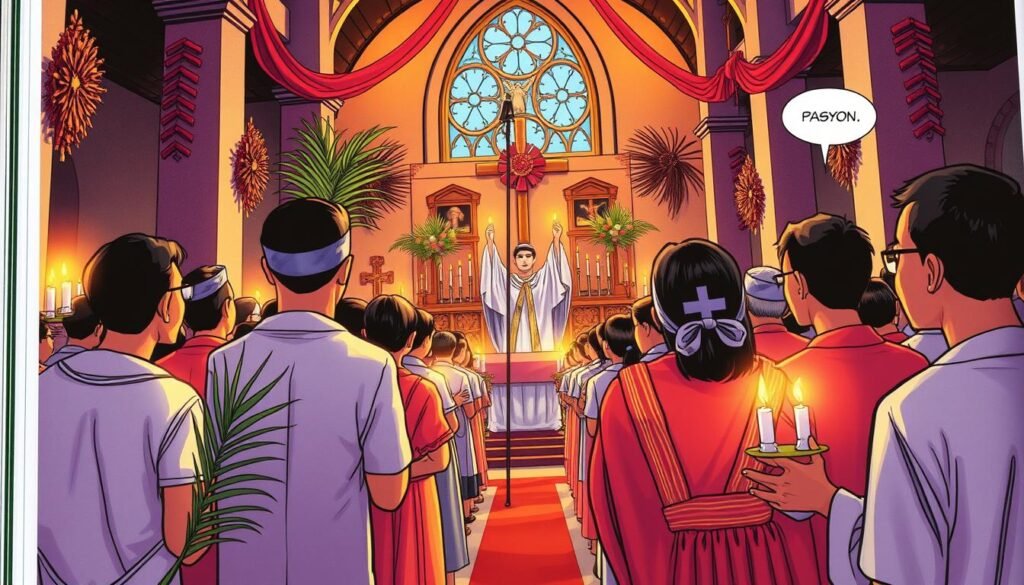
Families play a big role in chanting the Pasyon. They pass it down through generations. This strengthens family ties and shows the importance of faith and traditional practices.
Some key aspects of Pasyon traditional practices include:
- Community gatherings to chant the Pasyon
- Family participation in chanting and passing down the tradition
- Emphasis on faith and music during the Lenten season
Understanding these traditional practices helps us see Pasyon’s importance in Filipino culture. It shows how Pasyon shapes the country’s Holy Week celebrations.
The Role of Music in Pasyon
The Pasyon is deeply rooted in music, with its own melodies and rhythms. These evoke emotions and responses. In the Philippines, the Pabasa ng Pasyon is performed with stringed instruments or just voices. This creates a rich, immersive experience.
Chanting and music are key parts of Pasyon. Each region has its own style and interpretation. Melody and rhythm are vital, conveying emotions and creating a sense of community.
Instruments and Sounds During Chanting
In Pasyon chanting, instruments like guitars or violins are often used. These sounds blend with the chanters’ voices, creating a haunting beauty. Music in Pasyon is more than accompaniment; it’s a core part of the tradition.
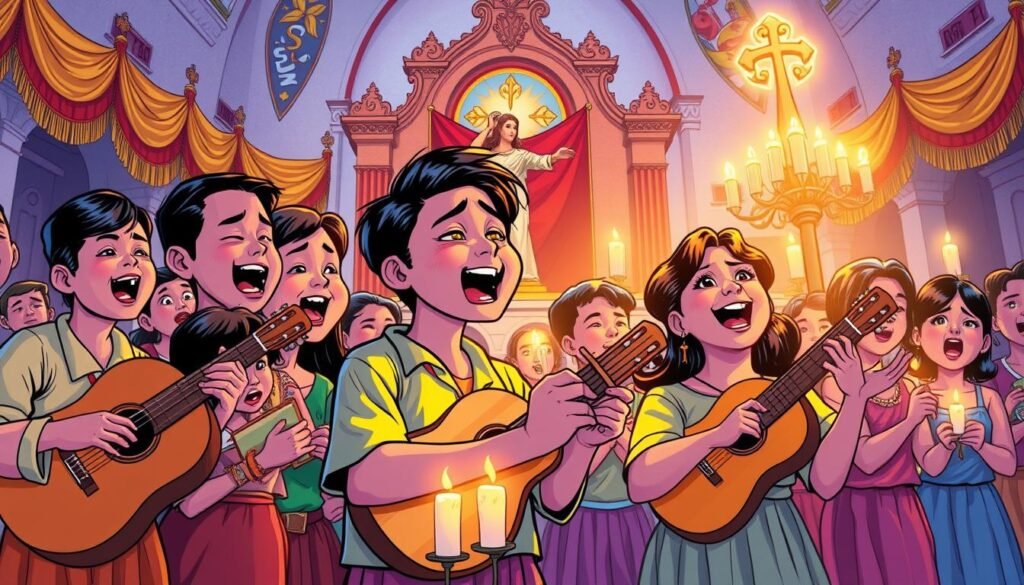
Importance of Melody and Rhythm
Melody and rhythm are essential in Pasyon chanting. They help convey emotions and the story’s message. The use of these elements creates a sense of tension and release, reaching a peak of emotion.
| Instrument | Description |
|---|---|
| Guitar | A stringed instrument often used to accompany Pasyon chanting |
| Violin | A stringed instrument used to add a haunting and mournful sound to Pasyon chanting |
Pasyon in Modern Times
The Pasyon, a long-standing Filipino tradition, has changed over time. It now fits the needs and tastes of today’s community. Thanks to technology, people can now share and enjoy the Pasyon online.
Even though fewer Filipino Catholics join in the Pasyon tradition today, efforts to keep it alive continue. Some groups use social media to share their Pasyon experiences and invite others to join. Others host community events to celebrate this tradition together.
Technology has greatly influenced the Pasyon. Now, people can chant the Pasyon from home. This has made the Pasyon more accessible, allowing people worldwide to connect with this vital part of Filipino tradition.

- Online platforms for sharing and experiencing the Pasyon
- Community events to bring people together and celebrate the Pasyon
- Efforts to preserve and promote the Pasyon as an important part of Filipino culture
| Year | Participation | Technological Advancements |
|---|---|---|
| 2010 | High | Basic social media platforms |
| 2020 | Medium | Advanced social media platforms, online streaming |
Educational Aspects of Pasyon
Pasyon is very important in Filipino education, mainly during Holy Week. It helps keep our culture alive by teaching it in schools. This way, we can learn and appreciate our heritage more.
The Pasyon teaches us about Filipino culture and history. It has deep themes and symbols. It also helps us understand social issues and freedom, as Reynaldo Ileto said. Plus, it improves our reading skills by introducing complex Tagalog words.
Some key aspects of Pasyon in education include:
- Teaching Pasyon in schools to promote cultural awareness and appreciation
- Using Pasyon as a tool for cultural preservation and education
- Providing a framework for social consciousness and liberation ideologies
- Contributing to literacy development through the reading and chanting of the Pasyon
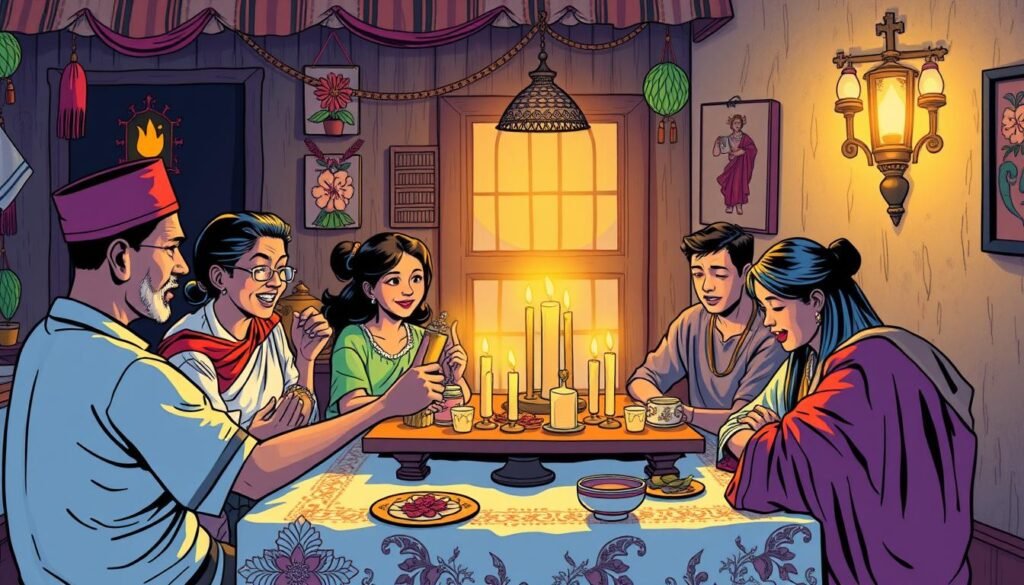
Pasyon is also part of university studies, showing its importance today. By teaching Pasyon, we can deepen our understanding of Filipino culture and history.
| Aspect of Pasyon | Significance in Education |
|---|---|
| Teaching Pasyon in schools | Promotes cultural awareness and appreciation |
| Using Pasyon as a tool for cultural preservation | Helps preserve Filipino culture and history |
| Providing a framework for social consciousness | Contributes to liberation ideologies and social change |
The Connection Between Pasyon and Other Holy Week Traditions
Pasyon is a key part of Holy Week in the Philippines, deeply rooted in tradition. It’s often paired with other rituals like the Stations of the Cross and processions. These add to the richness and diversity of the Holy Week experience.
The Pasyon is recited before Good Friday. Senakulo, a play about Christ’s Passion, is performed by local communities. Other traditions include the Visita Iglesia, where Catholics visit seven churches, and the Alay-Lakad, a penitential walk to the Antipolo Cathedral.
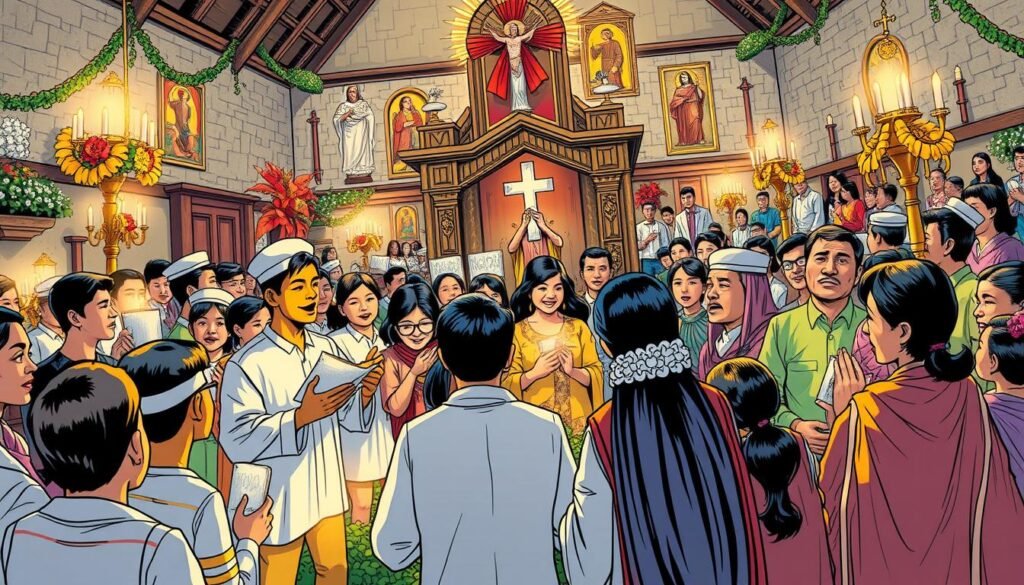
These Holy Week traditions are vital to Filipino culture. They help preserve the country’s tradition and heritage. As the Philippines changes, it’s important to keep traditional practices while embracing new ideas.
Some notable Holy Week traditions include:
- Self-flagellation and crucifixion reenactments in Pampanga
- Cooking traditional dishes such as “binignit” and “pansit”
- Gathering for a “handaan” to enhance family bonding
By understanding and appreciating these traditions, Filipinos can honor Holy Week with reverence. They can also pass these customs to future generations.
Challenges Facing the Pasyon Tradition
The Pasyon tradition is a big part of Filipino culture. But, it’s facing many challenges that might end it. In rural areas, fewer people are joining in, which is a big problem.
There’s also a worry about losing the tradition itself. With fewer people, it’s at risk of being forgotten. But, local communities are trying hard to keep it alive. They’re organizing cultural festivals and educational programs. Efforts to preserve the tradition are key to its survival.
Some ways to save the Pasyon tradition include:
- Cultural festivals to promote the tradition and encourage participation
- Educational programs to teach the younger generation about the significance of the Pasyon
- Community events to bring people together and keep the tradition alive
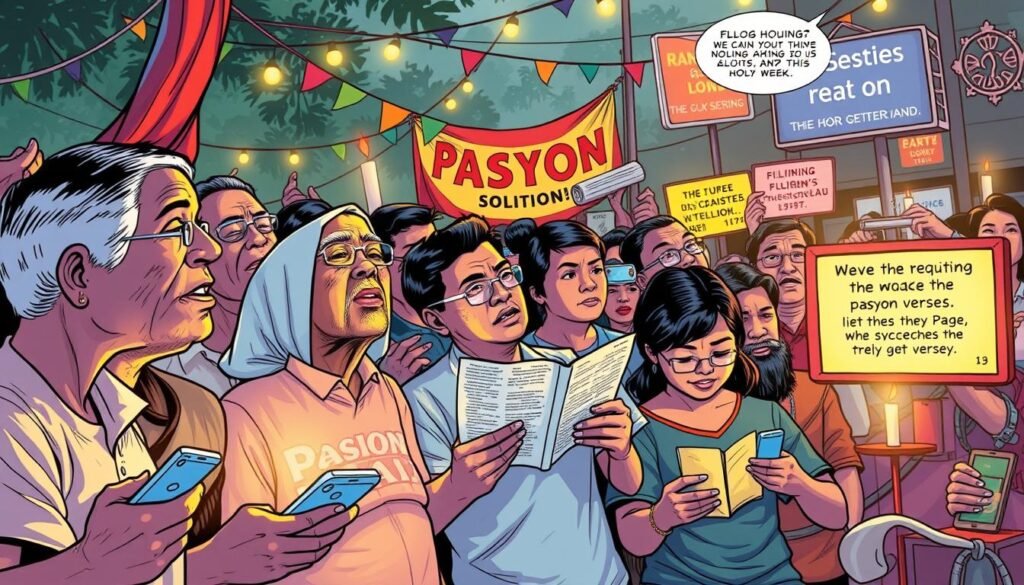
Even with challenges, the Pasyon tradition is vital to Filipino culture. It’s a tradition that has been passed down for generations. Preserving it is essential to keep the country’s cultural heritage alive. By working together, local communities can make sure the Pasyon tradition continues.
| Year | Number of Participants | Location |
|---|---|---|
| 2011 | 100 | Rural Area |
| 2015 | 50 | Rural Area |
| 2020 | 20 | Rural Area |
The Role of Church and Faith Leaders in Pasyon
The Pasyon is a spiritual practice that needs the help of faith leaders. In the Philippines, where most people are Catholic, the Catholic Church helps keep the Pasyon alive. Priests and parishes offer spiritual guidance and leadership to the community.
The Catholic Church has shaped the religious landscape of the Philippines. Many faith leaders use the Pasyon for spiritual growth. It’s not just a religious act but also a way to bond with the community and live a religious life.

Faith leaders play many roles in Pasyon. They guide spiritually, lead prayers, and keep the tradition alive. The Pasyon shows how religion can unite people and foster a sense of community. As the Philippines celebrates its culture, the role of faith leaders in Pasyon is vital to its spiritual identity.
Personal Reflections and Experiences with Pasyon
During Holy Week, many Filipinos take part in personal reflections through traditions like Pabasa chanting. This can be very emotional, helping people connect deeply with their faith. A story from a foreigner’s experience during Holy Week shows how important the Pabasa is in these celebrations.
The Pasyon chanting lasts from Ash Wednesday to Good Friday, a 40-day journey of personal reflections and spiritual growth. It’s a time to think about life, faith, and community. The chanting can make people feel a mix of emotions, from sadness to joy.

Testimonials from Participants
Many who chant the Pabasa share their personal reflections and experiences. They talk about feeling a strong sense of community and belonging. The Pasyon is more than a religious practice; it’s a cultural tradition that unites people.
Emotional Impact of Chanting
Chanting the Pasyon can have a deep emotional impact. Many feel peace, joy, and spiritual renewal. It creates a sense of unity and shared purpose. The Pasyon chanting is a key part of the Filipino community’s personal reflections and spiritual practices during Holy Week.
Future of Pasyon in Filipino Society
The Pasyon tradition has been a big part of Filipino culture for centuries. Its future depends on passing it down to younger generations. As the Philippines changes and modernizes, it’s key to keep the Pasyon relevant and meaningful to the youth.
Research shows the Pasyon has shaped the country’s history and identity. To keep it in the future, we need to get younger people involved. We must show them why the Pasyon is important in Filipino society.
Here are some ways to do this:
- Integrate the Pasyon into school curricula to teach students about its cultural value
- Host community events and activities to showcase the Pasyon’s relevance today
- Use social media and digital platforms to spread the word about the Pasyon

By working together, we can preserve and promote the Pasyon tradition. This will keep it relevant and important in the country’s future. It will also help keep our cultural heritage alive and connect us to our past.
| Year | Event | Significance |
|---|---|---|
| 1840 | Introduction of foreign capital | Disrupted pre-capitalist relations of production, affecting class dynamics |
| 1896 | Execution of Jose Rizal | Intensified the struggle against colonialism, contributing to the declaration of independence from Spain in 1898 |
Conclusion: The Lasting Legacy of Pasyon
The Pabása ng Pasyón, or the chanting of the Pasyon during Holy Week, is a timeless tradition. It continues to define the essence of Filipino identity and culture. This centuries-old practice has deep religious significance, serving as a powerful medium for personal devotion and community engagement.
Renowned historian Reynaldo Clemeña Ileto has shed light on the Pasyon’s role in Philippine revolutionary movements. It has provided a “language for articulating its own values, ideals, and hopes of liberation” for the common people. This rich tapestry of tradition, spirituality, and social consciousness shows the enduring relevance of the Pasyon in the lives of Filipinos, both past and present.
Looking to the future, it is essential that the Pasyon continues to be preserved, promoted, and passed down to new generations. By engaging with this timeless tradition, Filipinos can reaffirm their cultural heritage. They can find strength in the unifying power of shared faith and community. The Pasyon’s ability to transcend time and evolve with society is a testament to its profound and lasting legacy in the Philippines.
FAQ
What is the Pasyon tradition?
The Pasyon is a key part of Filipino culture and identity. It’s a book about the life of Christ. People chant it during Lent to seek forgiveness.
This tradition has been passed down for generations. It started in the 17th century.
What is the significance of Pasyon in Filipino culture?
The Pasyon shows the country’s rich cultural heritage. It mixes Catholicism with indigenous traditions. Chanting the Pasyon helps Filipinos connect with their faith and community.
It brings comfort, solace, and spiritual renewal.
What is the structure and content of the Pasyon?
The Pasyon explores themes like Christ’s passion and death. It talks about faith and redemption. The chanting is stylized and ritualized.
It has its own melodies, rhythms, and cadences.
What are the regional variations of Pasyon?
The Pasyon varies across regions. In Tagalog, Visayan, and Ilocano areas, it’s chanted in different languages. This shows the country’s linguistic and cultural diversity.
What are the traditional practices associated with Pasyon?
The Pasyon brings people together. Families and communities chant it together. This creates a sense of belonging and solidarity.
What is the role of music in Pasyon?
Music is central to the Pasyon. Its melodies and rhythms evoke emotions. The chanting is a powerful form of music with its own beauty.
How has Pasyon evolved in modern times?
The Pasyon has evolved with technology. Now, it’s more accessible online. This has made it easier for people to experience the chanting.
What are the educational aspects of Pasyon?
The Pasyon teaches about Filipino culture and history. It’s rich in themes and symbolism. Teaching it in schools helps preserve the tradition and promotes cultural awareness.
How is Pasyon connected to other Holy Week traditions?
The Pasyon is a key part of Holy Week. It’s chanted alongside other rituals like the Stations of the Cross. These practices enrich the Holy Week experience.
What are the challenges facing the Pasyon tradition?
The Pasyon faces challenges like declining participation in rural areas. There’s a risk it might be forgotten. But, local communities are working to keep it alive through festivals and education.
What is the role of church and faith leaders in Pasyon?
Faith leaders are vital for the Pasyon. Priests and parishes help promote and preserve it. They provide spiritual guidance and leadership.
What are the personal reflections and experiences with Pasyon?
The Pasyon is deeply personal and emotional. Participants share their stories and experiences. Chanting the Pasyon can be a powerful and moving experience.
Source Links
- Pabása ng Pasyón: Chanting the Passion for Holy Week in the Philippines – https://www.catholicsandcultures.org/philippines-centuries-old-tradition-chanting-passion-continues
- What is “Pabasa”? – https://manilacatholictraditions.wordpress.com/chanting-the-passion-of-christ/what-is-pabasa/
- Pasyon – https://en.wikipedia.org/wiki/Pasyon
- 5 Values to Learn From Filipino Holy Week Traditions — Knowledge Channel Foundation – https://www.knowledgechannel.org/articles/5-values-to-learn-from-filipino-holy-week-traditions
- Pasyon and Holy Week: A Study of Music, Acculturation, and Local Catholicism in the Philippines – http://philippineperformance-repository.upd.edu.ph/572/
- Preservation of Philippine Culture Through Notation of Century-old Passion Tunes – https://www.ijsrp.org/research-paper-0519/ijsrp-p8965.pdf
- CCP Encyclopedia of Philippine Art | CCP Encylopedia of Philippine Art – https://epa.culturalcenter.gov.ph/3/82/2262/
- Pasyon-Powerpoint para sa Junior High.pptx – https://www.slideshare.net/slideshow/pasyon-powerpoint-para-sa-junior-high-pptx/274658368
- PDF – http://www.philippinestudies.net/files/journals/1/articles/3940/public/3940-9065-1-PB.pdf
- SENAKULO – National Museum – https://www.nationalmuseum.gov.ph/2022/04/15/senakulo/
- Pabasa (ritual) – https://en.wikipedia.org/wiki/Pabasa_(ritual)
- Holy Week Traditions and Practices in the Philippines – https://thelookout.com.ph/article/holy-week-traditions-and-practices-in-the-philippines
- Traditional pabasa a dying passion? – https://www.philstar.com/headlines/2015/03/31/1439747/traditional-pabasa-dying-passion
- A SECOND LOOK AT OUR PABASA – VeritasPH – https://www.veritasph.net/a-second-look-at-our-pabasa/
- Wrong track to traditions – https://opinion.inquirer.net/103442/wrong-track-traditions
- Xavier University – Ang Pasyon ni Hesukristo: ‘I have saved you, I have died for you’ – https://www.xu.edu.ph/xavier-news/63-2017-2018/3330-ang-pasyon-ni-hesukristo-i-have-saved-you-i-have-died-for-you
- Pasyon and Holy Week for a Filipino Family – https://www.tumblr.com/casabayanihan/115803037750/pasyon-and-holy-week-for-a-filipino-family
- Pasyon – Traveler on Foot – https://traveleronfoot.wordpress.com/tag/pasyon/
- Traditional Pabasa: A Dying Passion? – https://republicasiamedia.com/generation/traditional-pabasa-a-dying-passion/
- Bookbed reviews: ‘Pasyon and Revolution’ by Reynaldo Clemeña Ileto – https://bookbed.org/2024/08/27/bookbed-reviews-pasyon-and-revolution-by-reynaldo-clemena-ileto/
- ‘Pasyon’ and ‘Semana Santa’ when I was young – https://coverstory.ph/pasyon-and-semana-santa-when-i-was-young/
- Saving Semana Santa: Tradition Transitions – https://thelasallian.com/2014/04/18/saving-semana-santa-tradition-transitions/
- Holy Week: A Time for Reflection, Bonding, and Togetherness… – https://www.edamama.ph/discover/nurture/holy-week-a-time-for-reflection-bonding-and-togetherness-for-filipino-families?srsltid=AfmBOooyKs-qqmoZsyEjJqDCyLe-y2mJ4iI2cg17IAXC_oMkBvc74zsk
- Have a hipper Holy Week with a rapped Pasyon – https://www.gmanetwork.com/news/lifestyle/artandculture/253828/have-a-hipper-holy-week-with-a-rapped-pasyon/story/
- Lent, a time for Filipinos to show devotion to God – https://www.pna.gov.ph/articles/1030309
- The Philippines’s alternative weekly magazine – https://www.bulatlat.com/news/6-10/6-10-pasyon.htm
- Understanding Folk Religiosity in the Philippines – https://www.mdpi.com/2077-1444/12/10/800
- Celebrating 500 years of Christianity in the Philippines – https://cbcpnews.net/cbcpnews/celebrating-500-years-of-christianity-in-the-philippines/
- Pasyon and Revolution – https://www.academia.edu/32372863/Pasyon_and_Revolution
- Through the Cross to the Light – World Mission – https://worldmissionmagazine.com/through-the-cross-to-the-light/
- Holy Week in the Philippines: A Time of Reflection and Rituals – Pinas Culture – https://pinasculture.com/holy-week-in-the-philippines-a-time-of-reflection-and-rituals/
- Ileto’s problematic class categories – https://josephscalice.com/2018/09/iletos-problematic-class-categories/
- The Shape of the Filipino Church to Come: A Vision of Renewal in Filipino Sacramental Worship – https://archium.ateneo.edu/cgi/viewcontent.cgi?article=1032&context=theology-faculty-pubs
- CGRN 2020 Template – https://ac.upd.edu.ph/acmedia/pdf/Moratilla_Hagiographic_Counterimaginary.pdf
- Reynaldo Ileto – https://en.wikipedia.org/wiki/Reynaldo_Ileto
- Inter-Religio 31 – https://nirc.nanzan-u.ac.jp/journal/7/article/1650/pdf/download

